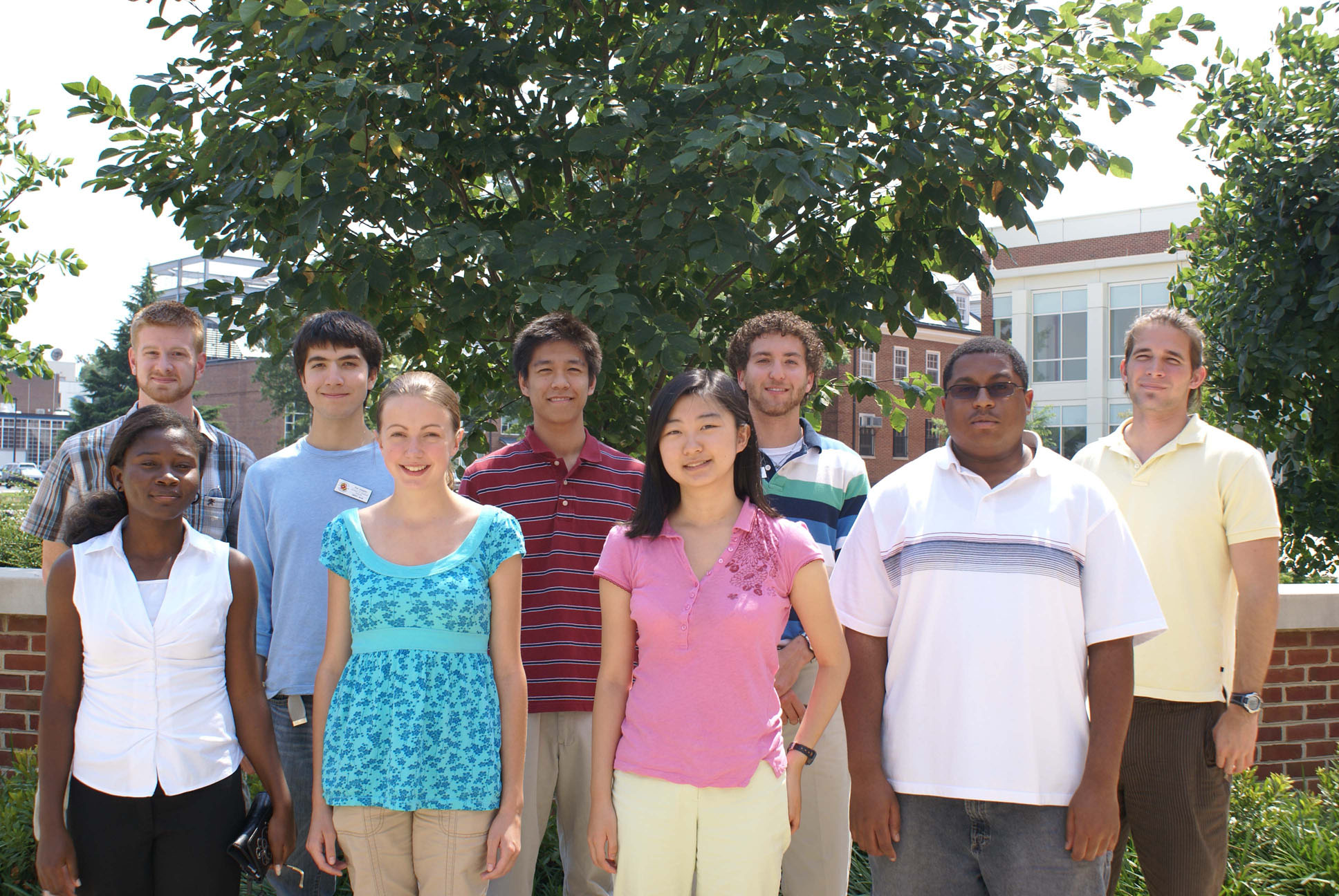| |
|
|
|
|
| |
|
|
|
|
| |
|
|
|
|
| |
|
MERIT
Fair 2008
|
|
|
| |
|
Overview, Project Abstracts, Presentation Slides & Posters, & Research Papers |
|
|
| |
|
Friday, August 8, 2008 |
|
|
| |
|
|
|
|
| |
|
|
|
|
| |
|
MERIT 2008 Student Participants
(click on photos to enlarge)
|
|
|
| |
|
The MERIT Fair is held
at the end of the summer to showcase the research conducted by the
undergraduate students during the summer. This forum provides the BIEN students
with the opportunity to present their work to the wider public.
Their efforts are subjected to scrutiny form a panel of judges selected
from academia, industry, and government laboratories. Prizes were awared for best
over all project, runner-up for best project, and best technical report. |
|
|
| |
|
|
|
|
| |
|
MERIT
Fair 2008 Prize Winning Projects |
|
|
| |
|
|
|
|
| |
|
|
|
|
| |
|
Biosystems Internships for Engineers (BIEN) |
|
|
| |
|
|
|
|
| |
|
|
|
|
| |
|
BIEN Project Abstracts, Technical Reports, and Presentation Slides |
|
|
| |
|
|
|
|
|
|
Biosensors for Cell Monitoring
Armstard Skipwith (University of Maryland, College Park)
Mentors:
Prof. Pamela Abshire (UMCP),
Nicole Nelson (UMCP) and
Somashekar Bangalore Prakash (UMCP).
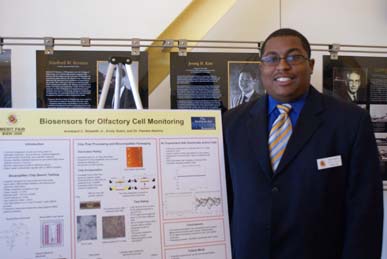 Integrating electronics with living cells could prove invaluable for medical diagnosis, pharmaceutical studies, or homeland security. A bioMEMS system was developed to detect the weak extracellular signals generated by electrically active cells. Spike signals from bovine aortic cells, similar to those of a neural discharge, have been observed. This project will extend that work by investigating the response of olfactory sensory neurons to various stimuli. This involves preparing existing fabricated chips for operation in continuous cell culture, modifying the current test setup for improved data acquisition, and conducting experiments in collaboration with neuroscientists at Johns Hopkins University. Integrating electronics with living cells could prove invaluable for medical diagnosis, pharmaceutical studies, or homeland security. A bioMEMS system was developed to detect the weak extracellular signals generated by electrically active cells. Spike signals from bovine aortic cells, similar to those of a neural discharge, have been observed. This project will extend that work by investigating the response of olfactory sensory neurons to various stimuli. This involves preparing existing fabricated chips for operation in continuous cell culture, modifying the current test setup for improved data acquisition, and conducting experiments in collaboration with neuroscientists at Johns Hopkins University.
Presentation Slides
Technical Report
|
|
|
|
|
Algorithms on Noisy Speech for Cochlear Implant Users
Jose A. Figueroa (University of Puerto Rico Mayagüez Campus)
Mentors:
Prof. Carol Espy-Wilson(UMCP), and
Vikramjit Mitra (UMCP)
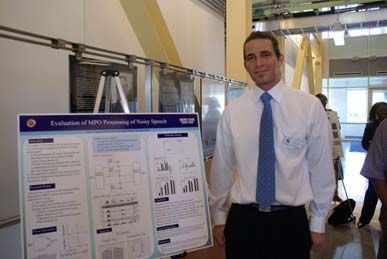 Current state-of-the-art speech recognition systems perform well in clean conditions. However, their performance drops drastically in everyday acoustically noisy environments. To address this issue, we are analyzing the Modified Phase Opponency (MPO) based speech enhancement algorithm which improves the signal-to-noise ratio of the signal while making no assumptions or needing any estimate of the noise. In particular, we compare our MPO-based algorithm against other techniques in a series of quality and intelligibility tests using both normal-hearing and hearing-impaired listeners. The speech signals are corrupted with car noise and speech-shaped noise. The results will show if it is worthwhile for us to explore the use of the MPO in hearing-aid and cochlear-implant devices. Current state-of-the-art speech recognition systems perform well in clean conditions. However, their performance drops drastically in everyday acoustically noisy environments. To address this issue, we are analyzing the Modified Phase Opponency (MPO) based speech enhancement algorithm which improves the signal-to-noise ratio of the signal while making no assumptions or needing any estimate of the noise. In particular, we compare our MPO-based algorithm against other techniques in a series of quality and intelligibility tests using both normal-hearing and hearing-impaired listeners. The speech signals are corrupted with car noise and speech-shaped noise. The results will show if it is worthwhile for us to explore the use of the MPO in hearing-aid and cochlear-implant devices.
Presentation Slides
Technical Report
|
|
|
|
|
Nanostructured Nickel Electrode Using Tobacco Mosaic Virus
Liliane Nguetsap (Montgomery College)
Mentors:
Prof. Reza Ghodssi (UMCP),
Konstantinos Geraspoulos (UMCP), and
Mariana Meyer (UMCP)
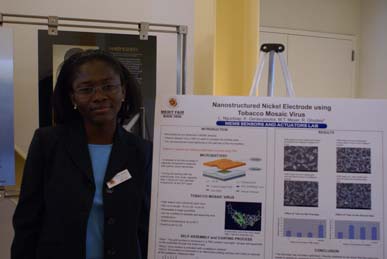 Microbatteries are essential in MEMS devices for energy storage and power generation. In this project, a nanostructured nickel electrode using Tobacco Mosaic Virus (TMV) is investigated. The use of the TMV helps to increase the surface area of the nickel electrode, which allows more reaction to take place in the cell, and hence improves the battery performance. The goal in this project is to optimize the current three-day-step process into a more efficient time frame. This work is expected to assist the existing process for the development of MEMS virus-based batteries. Microbatteries are essential in MEMS devices for energy storage and power generation. In this project, a nanostructured nickel electrode using Tobacco Mosaic Virus (TMV) is investigated. The use of the TMV helps to increase the surface area of the nickel electrode, which allows more reaction to take place in the cell, and hence improves the battery performance. The goal in this project is to optimize the current three-day-step process into a more efficient time frame. This work is expected to assist the existing process for the development of MEMS virus-based batteries.
Presentation Slides
Technical Report
|
|
|
|
|
An Analog VLSI Implementation of the Wake-Sleep Learning Algorithm Using Binary Synaptic Weights
Guy Lipworth (University of Florida)
Kyle McMillan (West Virginia University)
Mentors:
Prof. Timothy Horiuchi(UMCP),
Prof. Pamela Abshire(UMCP),
Timir Datta(UMCP), and
Anshu Sarje (UMCP)
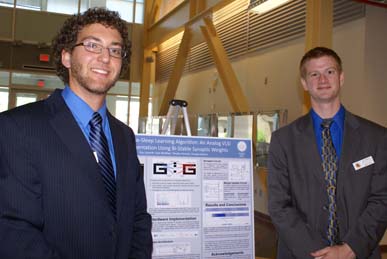 Drawing on biological systems for inspiration, typical supervised neural networks learn to classify items in a set of inputs through repetition. Here, we focus on using an auto-encoder network to memorize each item in a set of inputs rather than classify them. We have simulated this network in MATLAB using the "Wake-Sleep" learning algorithm proposed by Hinton et al. and demonstrated that the algorithm can be used successfully with binary synaptic weights trained in a bi-stable manner. Working from these simulations, we have designed and simulated a low power analog VLSI synapse circuit with binary weights that can implement the Wake-Sleep algorithm. Drawing on biological systems for inspiration, typical supervised neural networks learn to classify items in a set of inputs through repetition. Here, we focus on using an auto-encoder network to memorize each item in a set of inputs rather than classify them. We have simulated this network in MATLAB using the "Wake-Sleep" learning algorithm proposed by Hinton et al. and demonstrated that the algorithm can be used successfully with binary synaptic weights trained in a bi-stable manner. Working from these simulations, we have designed and simulated a low power analog VLSI synapse circuit with binary weights that can implement the Wake-Sleep algorithm.
Presentation Slides
Technical Report
|
|
|
|
|
Obstacle Avoidance and Boundary Following Inspired by the Echolocating Bat
Laura Freyman (University of Maryland at College Park)
Scott Livingston (University of Tennessee, Knoxville)
Mentors:
Prof. Timothy Horiuchi (UMCP),
Prof. P. S. Krishnaprasad (UMCP),
Prof. Cynthia Moss (UMCP),
Chen Chiu (UMCP),
Ben Falk (UMCP),
Kevin Galloway (UMCP), and
Matteo Mischiati (UMCP),
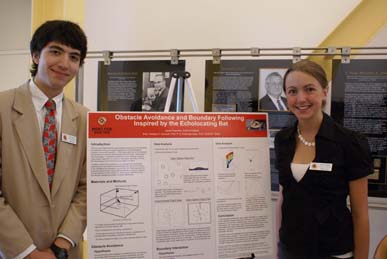 Developing a robust and rapid system for obstacle avoidance and boundary following has long been a goal of robotics research. In the spirit of bio-inspired engineering, we plan to study the flight behavior of the echolocating big brown bat, Eptesicus fuscus, and to mathematically model its ability to avoid obstacles and follow boundaries. Using inspiration from these models, we intend to create novel control algorithms for robots equipped with similar sensors to those of an echolocating bat. In addition, we hope that these algorithms will improve current understanding of the sensorimotor feedback loops employed by E. fuscus. Developing a robust and rapid system for obstacle avoidance and boundary following has long been a goal of robotics research. In the spirit of bio-inspired engineering, we plan to study the flight behavior of the echolocating big brown bat, Eptesicus fuscus, and to mathematically model its ability to avoid obstacles and follow boundaries. Using inspiration from these models, we intend to create novel control algorithms for robots equipped with similar sensors to those of an echolocating bat. In addition, we hope that these algorithms will improve current understanding of the sensorimotor feedback loops employed by E. fuscus.
Presentation Slides
Technical Report
|
|
|
|
|
Porous Silicon Waveguides for Biological and Chemical Detection
Anqi Fu (University of Maryland, College Park)
Mentors:
Prof. Tom Murphy(UMCP) and
Shu Zee Alencious Lo (UMCP)
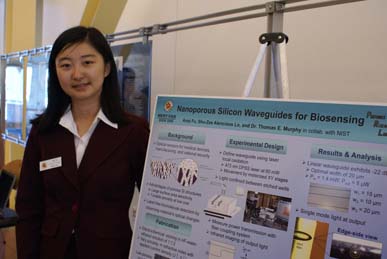 Nanoporous silicon waveguides are fabricated by electrochemical anodization in HF solution and laser local oxidation to form a two dimensional guiding structure. The resulting device is characterized using fiber coupling cutback techniques to determine their suitability for biodetection. Previous research has focused on simple linear waveguides, which exhibit high loss and unpredictable optical properties when exposed to biological agents. In this project, we extend the design to more complex interferometer structures in order to pinpoint the effect of surface molecular binding on the material’s optical behavior. Nanoporous silicon waveguides are fabricated by electrochemical anodization in HF solution and laser local oxidation to form a two dimensional guiding structure. The resulting device is characterized using fiber coupling cutback techniques to determine their suitability for biodetection. Previous research has focused on simple linear waveguides, which exhibit high loss and unpredictable optical properties when exposed to biological agents. In this project, we extend the design to more complex interferometer structures in order to pinpoint the effect of surface molecular binding on the material’s optical behavior.
Presentation Slides
Technical Report
|
|
|
|
|
Signal Processing with Magnetoencephalography in the Human Brain
Kahn Kevin (University of Maryland, College Park)
Mentors:
Prof. Jonathan Simon (UMCP) and
Nai Ding (UMCP)
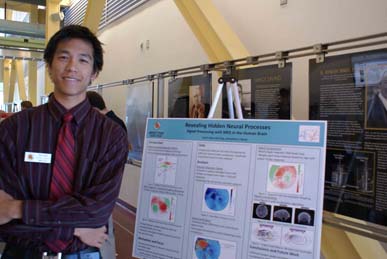 CMagnetoencephalography (MEG) is an important technique for brain imaging because of its good temporal resolution. It measures the magnetic field created by the flow of ions from neural activities. MEG is useful for studying the auditory cortex because of its orientation within the brain. While the evoked response to complex auditory stimuli shows the conventional auditory dipoles, examination of the induced power in the theta band shows a possible new dipole across the left frontal area. This study attempts to verify the validity of the dipole, localize its physiological source, and de-noise cardiac effects. CMagnetoencephalography (MEG) is an important technique for brain imaging because of its good temporal resolution. It measures the magnetic field created by the flow of ions from neural activities. MEG is useful for studying the auditory cortex because of its orientation within the brain. While the evoked response to complex auditory stimuli shows the conventional auditory dipoles, examination of the induced power in the theta band shows a possible new dipole across the left frontal area. This study attempts to verify the validity of the dipole, localize its physiological source, and de-noise cardiac effects.
Presentation Slides
Technical Report
|
|
|
| |
|
|
|
|
|

